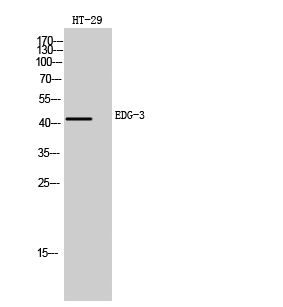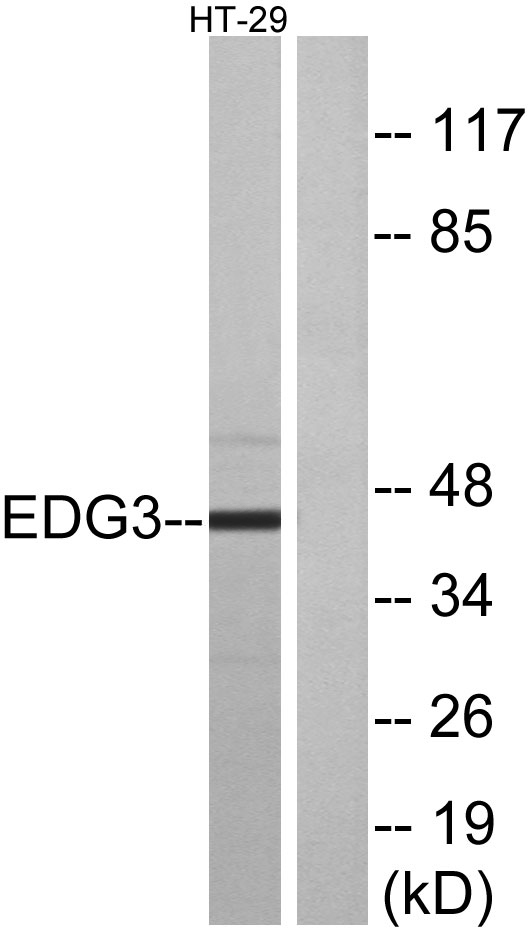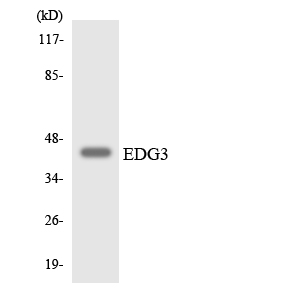EDG-3 Polyclonal Antibody
- Catalog No.:YT1462
- Applications:WB;IF;ELISA
- Reactivity:Human;Mouse;Rat
- Target:
- EDG-3
- Fields:
- >>Sphingolipid signaling pathway;>>Neuroactive ligand-receptor interaction
- Gene Name:
- S1PR3
- Protein Name:
- Sphingosine 1-phosphate receptor 3
- Human Gene Id:
- 1903
- Human Swiss Prot No:
- Q99500
- Mouse Gene Id:
- 13610
- Mouse Swiss Prot No:
- Q9Z0U9
- Immunogen:
- The antiserum was produced against synthesized peptide derived from human EDG3. AA range:115-164
- Specificity:
- EDG-3 Polyclonal Antibody detects endogenous levels of EDG-3 protein.
- Formulation:
- Liquid in PBS containing 50% glycerol, 0.5% BSA and 0.02% sodium azide.
- Source:
- Polyclonal, Rabbit,IgG
- Dilution:
- WB 1:500 - 1:2000. IF 1:200 - 1:1000. ELISA: 1:40000. Not yet tested in other applications.
- Purification:
- The antibody was affinity-purified from rabbit antiserum by affinity-chromatography using epitope-specific immunogen.
- Concentration:
- 1 mg/ml
- Storage Stability:
- -15°C to -25°C/1 year(Do not lower than -25°C)
- Other Name:
- S1PR3;EDG3;Sphingosine 1-phosphate receptor 3;S1P receptor 3;S1P3;Endothelial differentiation G-protein coupled receptor 3;Sphingosine 1-phosphate receptor Edg-3;S1P receptor Edg-3
- Observed Band(KD):
- 42kD
- Background:
- This gene encodes a member of the EDG family of receptors, which are G protein-coupled receptors. This protein has been identified as a functional receptor for sphingosine 1-phosphate and likely contributes to the regulation of angiogenesis and vascular endothelial cell function. [provided by RefSeq, Jul 2008],
- Function:
- function:Receptor for the lysosphingolipid sphingosine 1-phosphate (S1P). S1P is a bioactive lysophospholipid that elicits diverse physiological effect on most types of cells and tissues. When expressed in rat HTC4 hepatoma cells, is capable of mediating S1P-induced cell proliferation and suppression of apoptosis.,similarity:Belongs to the G-protein coupled receptor 1 family.,tissue specificity:Expressed in all tissues, but most abundantly in heart, placenta, kidney, and liver.,
- Subcellular Location:
- Cell membrane; Multi-pass membrane protein.
- Expression:
- Expressed in all tissues, but most abundantly in heart, placenta, kidney, and liver.
Hyperglycemia‐Triggered Sphingosine‐1‐Phosphate and Sphingosine‐1‐Phosphate Receptor 3 Signaling Worsens Liver Ischemia/Reperfusion Injury by Regulating M1/M2 Polarization. LIVER TRANSPLANTATION Liver Transplant. 2019 Jul;25(7):1074-1090 WB Mouse 1:100 Liver
Salidroside Inhibits CCl4-Induced Liver Fibrosis in Mice by Reducing Activation and Migration of HSC Induced by Liver Sinusoidal Endothelial Cell-Derived Exosomal SphK1. Frontiers in Pharmacology Front Pharmacol. 2021 May;0:1195 WB Mouse,Human Liver,serum exosomes
Yuan Chang, Hu, et al. "Hyperglycemia Triggered S1P/S1PR3 Signaling Worsens Liver Ischemia/Reperfusion Injury by Regulating M1/M2 Polarization." Chao and Yang, Shikun and Cheng, Xuyu and Cheng, Feng and Rao, Jianhua and Wang, Xue-Hao, Hyperglycemia Triggered S1P/S1PR3 Signaling Worsens Liver Ischemia/Reperfusion Injury by Regulating M 1 (2018).
- June 19-2018
- WESTERN IMMUNOBLOTTING PROTOCOL
- June 19-2018
- IMMUNOHISTOCHEMISTRY-PARAFFIN PROTOCOL
- June 19-2018
- IMMUNOFLUORESCENCE PROTOCOL
- September 08-2020
- FLOW-CYTOMEYRT-PROTOCOL
- May 20-2022
- Cell-Based ELISA│解您多样本WB检测之困扰
- July 13-2018
- CELL-BASED-ELISA-PROTOCOL-FOR-ACETYL-PROTEIN
- July 13-2018
- CELL-BASED-ELISA-PROTOCOL-FOR-PHOSPHO-PROTEIN
- July 13-2018
- Antibody-FAQs
- Products Images

- Yuan Chang, Hu, et al. "Hyperglycemia Triggered S1P/S1PR3 Signaling Worsens Liver Ischemia/Reperfusion Injury by Regulating M1/M2 Polarization." Chao and Yang, Shikun and Cheng, Xuyu and Cheng, Feng and Rao, Jianhua and Wang, Xue-Hao, Hyperglycemia Triggered S1P/S1PR3 Signaling Worsens Liver Ischemia/Reperfusion Injury by Regulating M 1 (2018).

- Western Blot analysis of HT-29 cells using EDG-3 Polyclonal Antibody

- Western blot analysis of lysates from HT-29 cells, using EDG3 Antibody. The lane on the right is blocked with the synthesized peptide.

- Western blot analysis of the lysates from HepG2 cells using EDG3 antibody.



